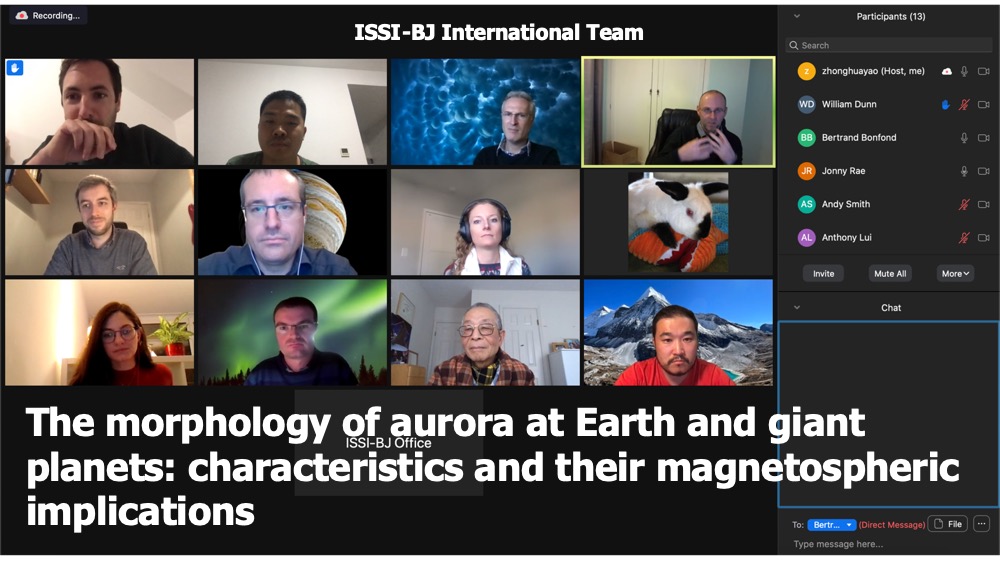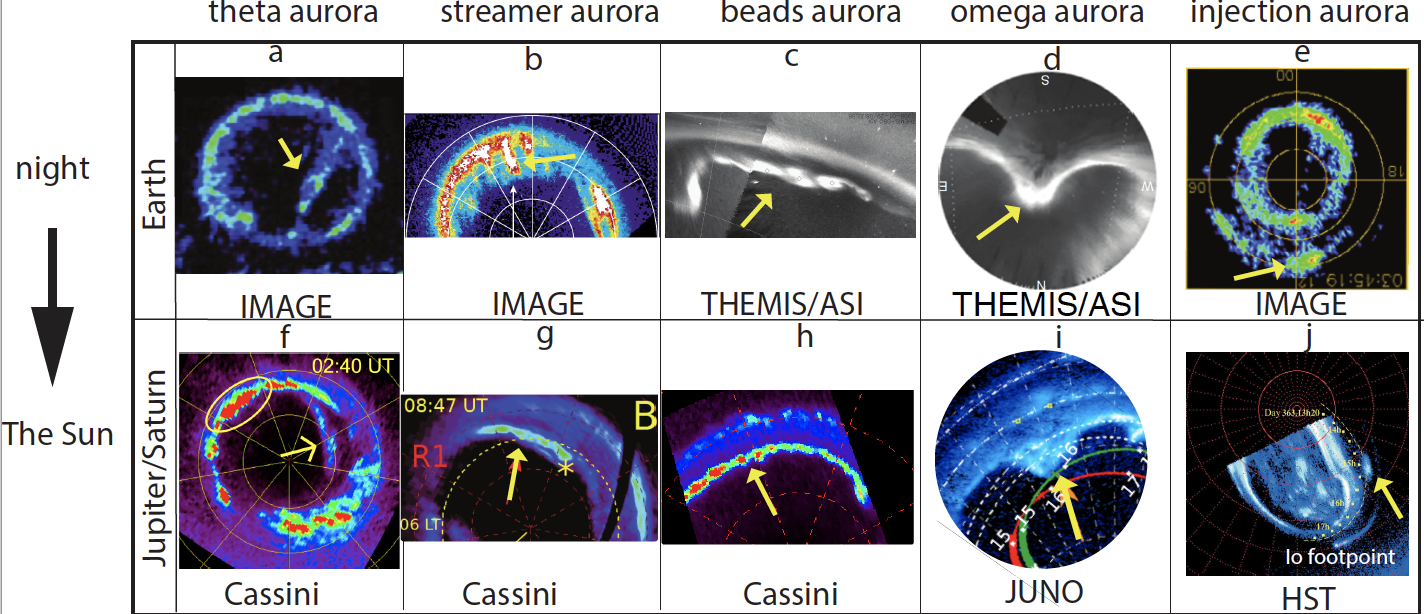A chat with YAO Zhonghua (University of Liege) and his team working on “The morphology of aurora at Earth and giant planets: characteristics and their magnetospheric implications”
This ISSI-BJ team, made up of ca. 12 scientists from different backgrounds and research areas—planetary and space science, physics, astrophysics—was approved by the ISSI/ISSI-BJ Science Committee in 2019. Led by YAO Zhonghua (University of Liege, Belgium) and SHI Quanqi (Shandong University, China), the group, characterized by its multi- and interdisciplinarity, has made breakthrough discoveries that have been published in the past few months. One of its members, William Dunn, recently received the 2021 Division Outstanding Early Career Scientist Awards from the European Geosciences Union.
Given the current circumstances, the team was not able to organize its first in-person meeting at ISSI-BJ in 2020; nonetheless, since they’ve seized the chance to meet online for the first time in November 2020, they have organized one more meeting and are planning to have more on a regular basis to keep their cooperative research going and make the most out of the resources currently available. Thus, we’ve asked Prof. Yao a couple of questions about their research, how they organize their work online, and their future scientific plans.

1. Dear Prof. Yao, could you give us a brief introduction to your team and your research focus?
Sure, it is my honor to introduce our team. Our team members come from very different and varied backgrounds, including theoreticians, data scientists, and modelers from both the terrestrial and giant planetary scientific communities. As we know, the planets of our solar system present very different characteristics, such as solar wind states at different distances and different moons’ geological activities. Nevertheless, the Earth’s magnetic field and the magnetic fields of giant planets present numerous similarities in fundamental magnetospheric processes. There’s the need to advance the studies on the similarities between the terrestrial and the giant planetary backgrounds; however, the combination of the results from both in data analysis is not straightforward. Thanks to the magnetospheric space missions (Cluster, THEMIS, Van Allen Probes, and MMS), the global picture of terrestrial magnetospheric dynamics has significantly shifted in the past two decades. Similarly, the understanding of the giant planetary magnetosphere has also significantly improved thanks to the Cassini, Galileo, and Juno spacecraft as well as space/ground observatories. Therefore, researchers in the cutting edge of both communities need to work together and carefully compare the progress and results in each study area.
Our research focuses on the comparison of the fundamental magnetospheric and auroral processes around the Earth and giant planets – Jupiter and Saturn. Due to the different planetary environments, one fundamental plasma process may result in very different observational features at different planets. For example, due to the rapidly co-rotating nature of giant planetary magnetospheres, the auroral evolution is strongly modulated by azimuthal rotation, showing very different morphologies in comparison to the terrestrial aurorae. Our team members who are proficient in terrestrial and giant planetary fields are the ideal candidates to identify the fundamental magnetospheric processes by comparative investigations of different planets.
2. Could you please tell us more about your personal background and why did you choose ISSI-BJ International Teams Program?
Unlike most other researchers, I have often changed my research topic since my graduate studies, spanning from nuclear fusion to terrestrial sub-storms, Saturn’s magnetosphere, and Jupiter’s aurora in the past ten years. Nonetheless, as all my research focuses are based on a central theoretical frame named plasma physics, I would probably describe my career as the application of plasma physics to different environments. In my research experience, I noticed that similar morphologies and terminologies are often used in different communities, demonstrating the importance of knowledge transfer between different fields. However, similar morphologies may be misleading if the differences of planetary environments are not considered. Furthermore, I have also realized that terminologies are transferred only based on similar morphologies, but not on fundamental physics. Therefore, my collaborators and I feel that it is very important to create a team that can focus on fundamental processes rather than morphologies. If we understand the fundamental processes, we will have a better understanding of the similarities and differences of morphologies or observational signals.
3. Is there any breakthrough discovery that you would like (and can) share with us?
Several breakthrough discoveries are resulting from our teamwork. Some of them are already available, and some others are still work-in-progress. Our team has paid special attention to the fundamental processes on different planets, including plasma injection, ion aurora, substorm, field-aligned current formation, magnetic reconnection, and dipolarization, etc.
I would like to highlight two breakthrough discoveries made by our team, i.e., Bonfond et al. (2021) and Zhang et al. (2021).
Bonfond et al. (2021) discovered for the first time the development of Jupiter’s dawn storm from the onset. Jupiter has many distinct auroral features; among them, the dawn storm is quite spectacular and rapidly evolving, indicating the most intense perturbations of energetic particles and electromagnetic fields in Jupiter’s magnetosphere. Before the Juno era, the Hubble Space Telescope has captured the dawn storm on the morning side, while the onset on the night side cannot be captured due to the limited viewing field. Using the new dataset from the Juno ultraviolet spectrograph, Bonfond et al. (2021) were successful in detecting all the stages of the development of dawn storm events, and the authors further reveal surprising similarities with terrestrial substorms. These findings demonstrate that, regardless of their sources, the dissipations of magnetospheric energy share fundamental similarities. The paper has been recently published by the high-impact journal “AGU Advances”.

Comparative auroral structures. Credit: YAO Zhonghua
Zhang et al. (2021) solved the long-existing question of Jupiter’s unique ability to produce the near-pole aurora. Jupiter has the most powerful aurora emission in our solar system as a consequence of the most energetic planetary space aurora. Although the morphology of Jupiter’s aurora was discovered in the 1990s by the Hubble Space Telescope, the reason why there is a great number of auroral emissions near the magnetic pole, which was confirmed to not exist on the Earth and Saturn, was still an open question. Based on first-principles and physics-based calculations, Zhang et al. (2021) discovered that most of the Jovian polar region is threaded by helical, closed magnetic field lines connecting the two magnetic poles. Since planetary space environments are connected via magnetic fields, the novel magnetic topology revealed in this study will reshape the current understanding of Jupiter’s energy and mass coupling picture. Their results demonstrate that the Earth and Saturn’s magnetic field configuration is only a simplified condition, i.e. magnetic field with a negligible helicity, while Jupiter’s configuration is the fundamental situation. The paper has been published by the highly influential journal “Science Advances”.
4. How do you think these online meetings are contributing to the advancement of your research?
It sounds self-evident, as we are 12 scientists from five different countries—Belgium, Greece, UK, USA, and China—but being all in the same virtual room at the same time made us open our eyes to the cultural differences that can enrich us and contribute to our research. Our members contribute to the research by bringing in multiple perspectives and views thanks to their different scientific backgrounds. This was possible given my work experience that spans several countries, projects, and organizations, where I got to meet and work with experts from various research fields. That’s unique, as I’m in the position of being able to grasp everyone’s perspective on our common topic and mediate with others to contribute to a deeper understanding of the subject. We address tough subjects that require our painstaking attention, but if we raise our gaze to look beyond our research area, we may realize that there are fundamental flaws, misunderstandings, or loopholes produced by a non-comprehensive, non-interdisciplinary approach. We should focus discussions on specific subjects, but having representatives of various disciplines in the same research group makes the brainstorming sessions much more stimulating and productive.
5. What are some of the challenges of organizing online meetings?
Apart from the linguistic and cultural obstacles that we may face now and then, probably the biggest difficulty is to find a common date and time to hold the meeting, as we come from three different continents. We often have to choose the night slot in China and the morning slot in the USA to make sure we’ll all get the chance to join the discussion. We are looking forward to the in-person meetings, but until then, we plan to have one online meeting per month.
6. What's the status of your team's research and what's the next step?
In our monthly meeting, we focus on those subjects that would likely bring new publications in the near future. For example, in our second and third meetings, we discussed auroral beads and plasma injection, respectively. Our team members are working on these subjects in either terrestrial or giant planetary space environments so that the focused discussions from the two sides are timely in their research and will be useful to achieve high-impact results. At the end of the ISSI-BJ meetings, we expect to have breakthrough discoveries in several key research areas and eventually provide an improved bigger picture of comparative auroral processes between the Earth and giant planets.
Our team members just started working on comparing the auroral processes of the Earth and Jupiter/Saturn. I can foresee many more collaborations to come in the future. Several publications will probably result from the team discussion, and I plan to lead a review paper on comparative auroral processes at different planets.
Many thanks to Prof. Yao for his time and his exhaustive answers, and congratulations on their publications!
References
Bonfond, B., Yao, Z. H., Gladstone, G. R., Grodent, D., G rard, J.C., Matar, J., et al. (2021). Are dawn storms Jupiter's auroral substorms?. AGU Advances, 2, e2020AV000275. https://doi. org/10.1029/2020AV000275
Zhang, Binzheng, Peter A. Delamere, Zhonghua Yao, Bertrand Bonfond, D. Lin Kareem A. Sorathia, Oliver J. Brambles, William Lotko, Jeff S. Garretson, Viacheslav G. Merkin, Denis Grodent, William R. Dunn, and John G. Lyon. How Jupiter’s unusual magnetospheric topology structures its aurora. Science Advances, Vol. 7(15). DOI: 10.1126/sciadv.abd1204